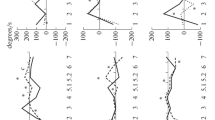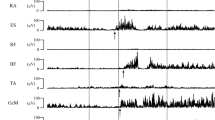Abstract
The aim of this study was to investigate the motor pattern during the standing long jump in the mentally retarded. The subjects included 34 elementary pupils and 16 upper secondary students in a school for the mentally retarded, aged 6–12 and 17–18 years, respectively. Their form in the standing long jump was shot with a video camera, and every frame was analyzed with reference to the developmental sequence for the standing long jump proposed by Clark et al. (1985) and Miyamaru (1973). The results showed that the development of arm action while performing the jump tended to occur behind that of leg action. In 10 elementary pupils, practicing the long jump facilitated differentiation between development of arm pattern and leg pattern. In flight, some of the upper secondary students showed a sideward-upward action of the arms although the backward movement of the swung arm was complete at takeoff. The results are discussed in terms of the poor balance of the mentally retarded.
Access this chapter
Tax calculation will be finalised at checkout
Purchases are for personal use only
Preview
Unable to display preview. Download preview PDF.
Similar content being viewed by others
References
DiRocco PJ, Clark JE, Phillips SJ (1987) Jumping coordination patterns of mildly mentally retarded children. APA Quart 4:178–191
Clarke JE, Phillips AJ (1985) A developmental sequence of the standing long jump. In: Clarke JE, Humphrey JH (eds) Motor development. Princeton Book, Princeton, NJ pp 73–85
Miyamaru A (1973) Development of basic motor patterns in young children 2: developmental process in jumping pattern. Bulletin of Tokyo Women’s College of Physical Education 8:40–54
Matsuzaki Y (1986) Posture control in Down syndrome children maintaining upright standing posture. Jpn J Spec Educ 24(2): 1–9
Matsuzaki Y (1987) Dynamic balance in mentally retarded children in a stabilometer task. Jpn J Develop Disab 9:225–231
Rider RA, Mahler TJ, Ishee J (1983) Comparison of static balance in trainable mentally handicapped and nonhandicapped children. Percept Motor Skills 56:311–314
Porretta DL (1988) Contextual interference effects on the transfer and retention of a gross motor skill by mildly mentally handicapped children. APA Quart 5:332–339
Kusano K (1986) A psychological approach to the motor training of mentally retarded children. Asian Scientific Congress Proceedings—Better life through sports, pp 506–511
Editor information
Editors and Affiliations
Rights and permissions
Copyright information
© 1994 Springer-Verlag Tokyo
About this paper
Cite this paper
Matsuzaki, Y., Hentona, T. (1994). Motor Pattern During the Standing Long Jump in Individuals with Mental Retardation. In: Yabe, K., Kusano, K., Nakata, H. (eds) Adapted Physical Activity. Springer, Tokyo. https://doi.org/10.1007/978-4-431-68272-1_21
Download citation
DOI: https://doi.org/10.1007/978-4-431-68272-1_21
Publisher Name: Springer, Tokyo
Print ISBN: 978-4-431-68274-5
Online ISBN: 978-4-431-68272-1
eBook Packages: Springer Book Archive




